Enterprise Service Design –
orchestrating systemic change.
Fundamentals
by Peter Horvath, with contributions from Jesse Anton and Nathalie Raux-Copin
Date: 09 March 2021
During its growth, Service Design focused heavily on definitions and its toolkit. But it failed to define what lies between these endpoints. While this is enough for practitioners, it falls short in the boardroom.
Here we propose to fill this missing middle, by focusing not on the usual ‘how’, but rather on the ‘why’. As a result, we define a remit and four approaches to Service Design (inside out, outside in, top-down, bottom-up), to facilitate discussions between Business, Technology, and Service Design professionals.
Four ways to drive transformation and create sustainable value through Service Design
What is Service Design?
It is a relatively young and ambitious human-centered discipline, brought to life by the service sector’s increasing prominence. It uses a holistic and collaborative approach to generate value for both the service user and the service provider throughout the service’s lifecycle. It choreographs processes, technologies, and interactions driving the delivery of services.
Something is missing
Have you ever felt something is missing from Service Design (SD)? I know, how could something be missing, when Service Design already encompasses or touches upon almost all aspects of an organization? And yet, there is something strange about it. It can be introduced in one sentence… but then one must dive straight into the toolkit. The ever-expanding, detailed, hands-on toolkit.
But there is a cliff in the unfolding storyline. Between the high-level definitions and the detailed toolkits, the middle of Service Design seems to be missing.
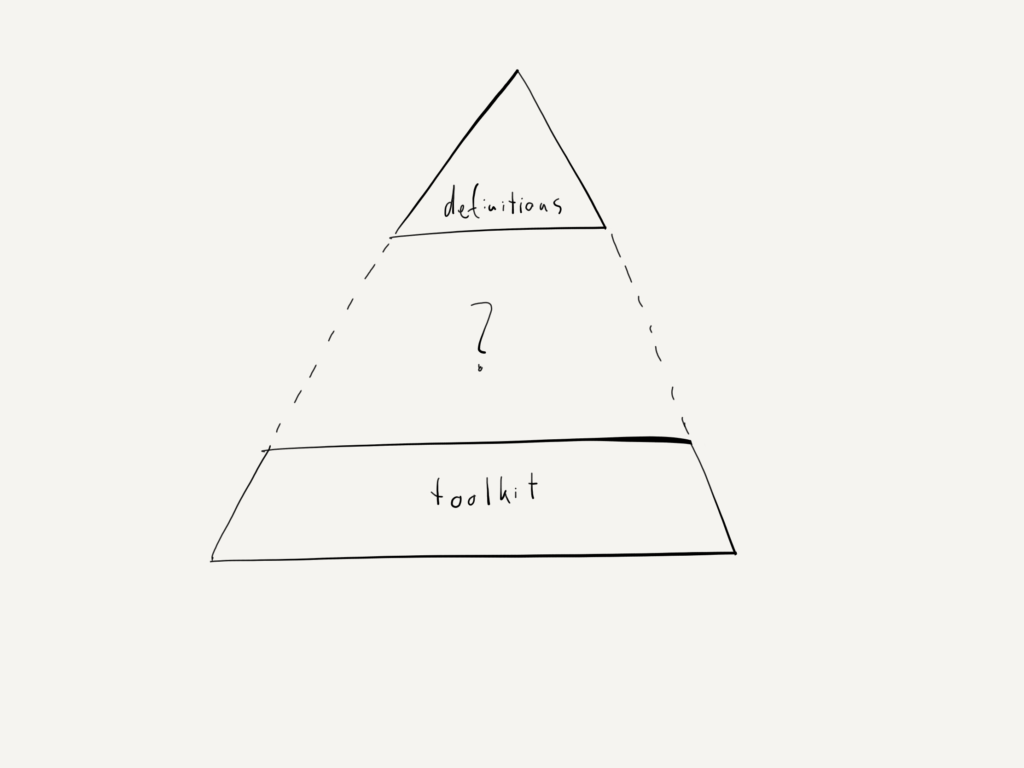
We set out to fix that. For this we compiled the many service design definitions, approaches, and toolkits, to provide a proposal of our own to fill up this ‘missing middle’. But this is just the beginning — see our call to action at the end of this article.
There are a number of challenges with Service Design:
- It is often described as a mix of other disciplines, e.g. saying that “Service Design borrows from everything and everyone to solve problems” (see source). As such, it lacks its own domain, unable to bring plans into reality, and depending on other disciplines and their goodwill for implementation.
- It is additive, rather than subtractive. Service Design initially focused on the touchpoints between the organization and its customers. Over time, a focus on employees has been added to the mix. Then the ecosystem in which an organization operates. Today more and more practitioners describe their activity as “designing the organization itself”. And you would be hard-pressed to hear a service designer say, “SD should not be involved in this project”. Its holistic nature is one of the allures of the domain. But this way, Service Design lacks an area of its own responsibility and is currently only a discipline to be consulted (more on this later).
- It focuses disproportionally on the ‘how’. It is much easier to find books or articles on the toolkit of Service Design than resources about its strategic approach. And yes, knowing which tool to use when, is hugely important — but still it’s only one side of the story. As such, Service Design doesn’t lend itself easily to boardroom discussions, because the focus quickly changes to hands-on details. Service Design thus often commits the cardinal sin: being inside-out, focusing on the service designer instead of the beneficiary.
- A culmination of the above is that service designers often don’t call themselves service designers. Either because the title does not exist in the organization, or in the case of consultancies, because unaided recall of the term ‘Service Design’ is low, making sales efforts difficult. Practitioners often use an established term, such as strategy, organization development, user experience, or even marketing. As such, not only does Service Design currently have the above challenges, it also is not doing a lot to claim its own domain.
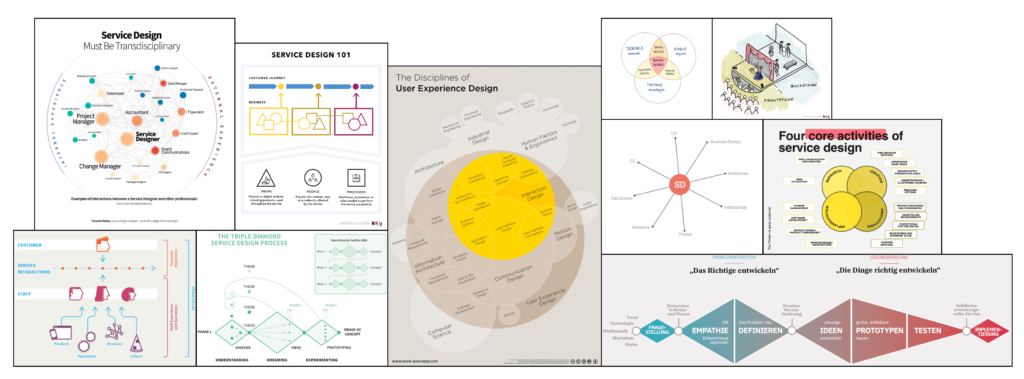
Why fill the missing middle?
Before we propose something, let’s stop and think. Why would this missing middle be needed at all? Service designers often argue that they are not worried about Service Design’s definition — they think in terms of similarities, instead of differences between disciplines. So as long as you find the common ground with your partners, everything will work out well, right?
Well, there is one problem with that. It may work in a few awesome organizations, in individual instances, or in an ideal world. But for any domain to grow, it needs attention, an area of responsibility, a dedicated budget, and ideally P&L responsibilities. Because as long as a domain depends on goodwill and budget of other departments, those other departments will put their own specific remit first, once push comes to shove.
And even if a definition for SD is not mandatory, clarity on remit certainly is.
So for Service Design to evolve and gain more ground as a discipline, its remits would need to be defined. Otherwise, due to the above 4 challenges, it risks being seen as a jack-of-all-trades-but-master-of-none. Or in the worst case, as a nuisance trying to force its authority on strategies and tactics of other disciplines.
So how do we get there? In four steps. (I.) First, analysis, breaking down existing views of Service Design into their elements and identifying gaps. (II.) Second, synthesis, constructing a narrative using the most important elements. (III.)Third, guidance on navigating this narrative. And (IV.) finally, defining a remit and responsibilities.
I. Activity breakdown and gap analysis
Most definitions and visualizations of Service Design that we found focus on a few recurring themes (see some in the illustration above). We categorized these themes as per below:
- Overlaps with related disciplines (e.g. marketing, architecture, UX)
- Approaches, tools, processes (e.g. holistic, empathy, customer journey)
- Activities (e.g. research, ideation, prototyping, orchestration)
- Objects of design (e.g. props, customer, staff, processes)
- Models (e.g. double diamond; frontstage & backstage)
- Intangible outcomes (e.g. useful, usable, effective, efficient, etc.)
Most organizations, whether for-profit or non-profit do not care about the ‘how’, i.e. the first 5 categories. (Unless they are Service Design fanatics.) However, the 6th category, ‘intangible outcomes’, is something they would care about. So let’s focus on that, and disregard the others for now.
Next, let’s look at gaps of the above 6 Service Design themes. This should be driven by the strategic focuses of organizations. We identified 4 such themes:
- Business outcomes
- Delivered (non-business) value
- Departments and internal stakeholders
- External stakeholders
We believe that the narrative to engage senior and business decision-makers should focus on these four categories, plus the ‘intangible outcomes’ from the first list. But what should that narrative look like?
II. Constructing a narrative
The explanation of Service Design should unfold gradually, as elements bubble to the surface.
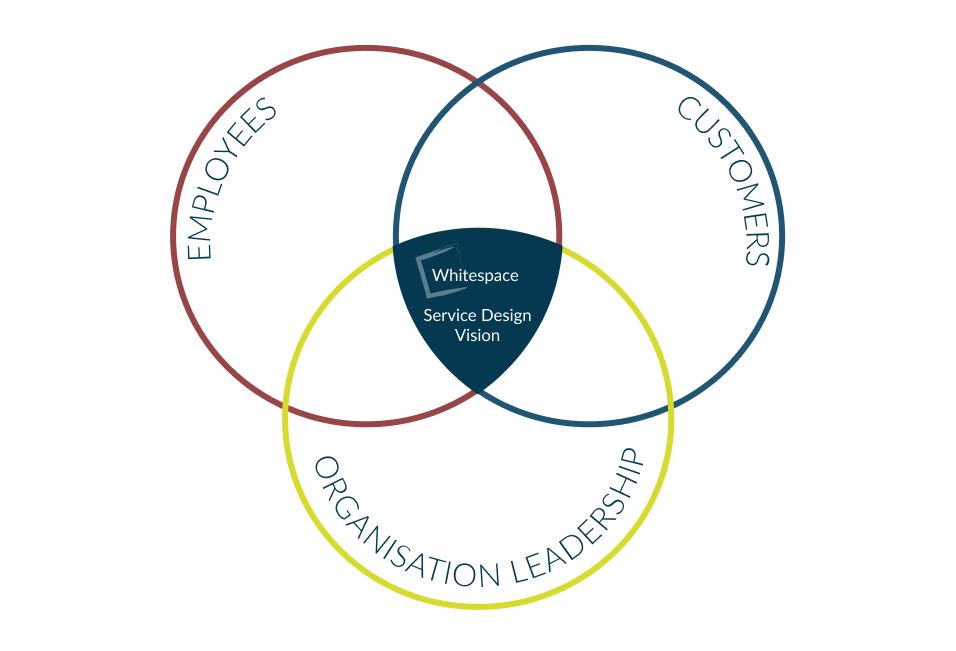
To start, pick your favorite (or your own) Service Design definition. Then you introduce the protagonists of the story, namely the customers, the employees, and the organization itself.
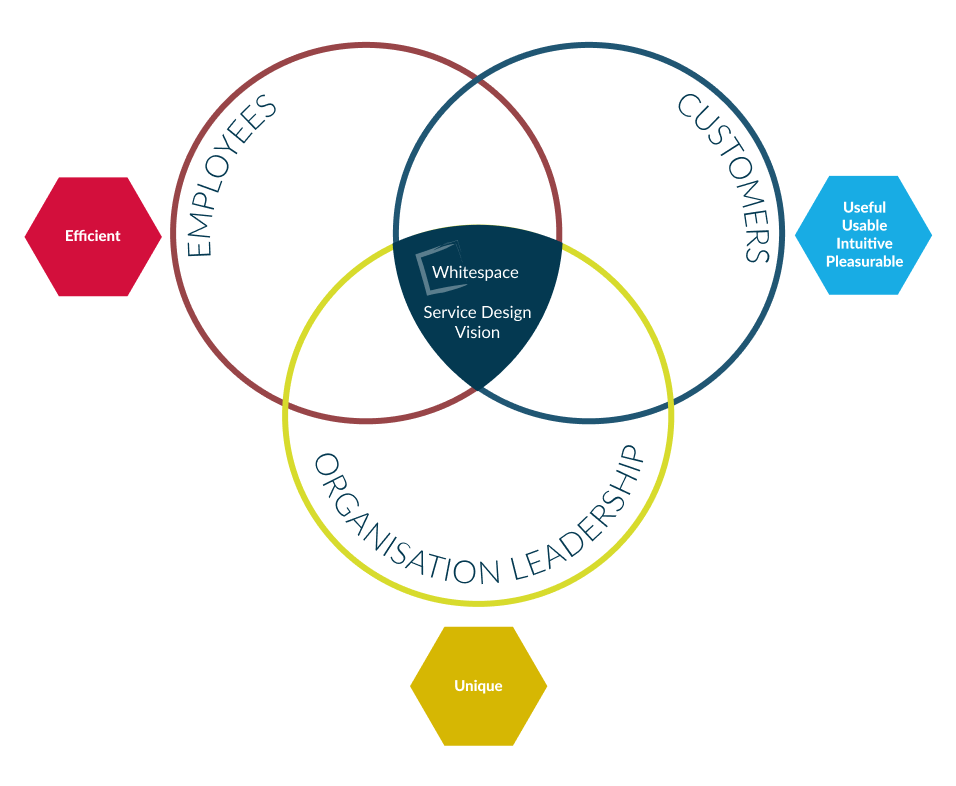
As a next step, you need to provide something of value. These will be the intangible outcomes discussed earlier, specifically:
- useful, usable, intuitive, and pleasurable services for the customers
- efficient service for employees, and
- unique service form the point of view of the organization
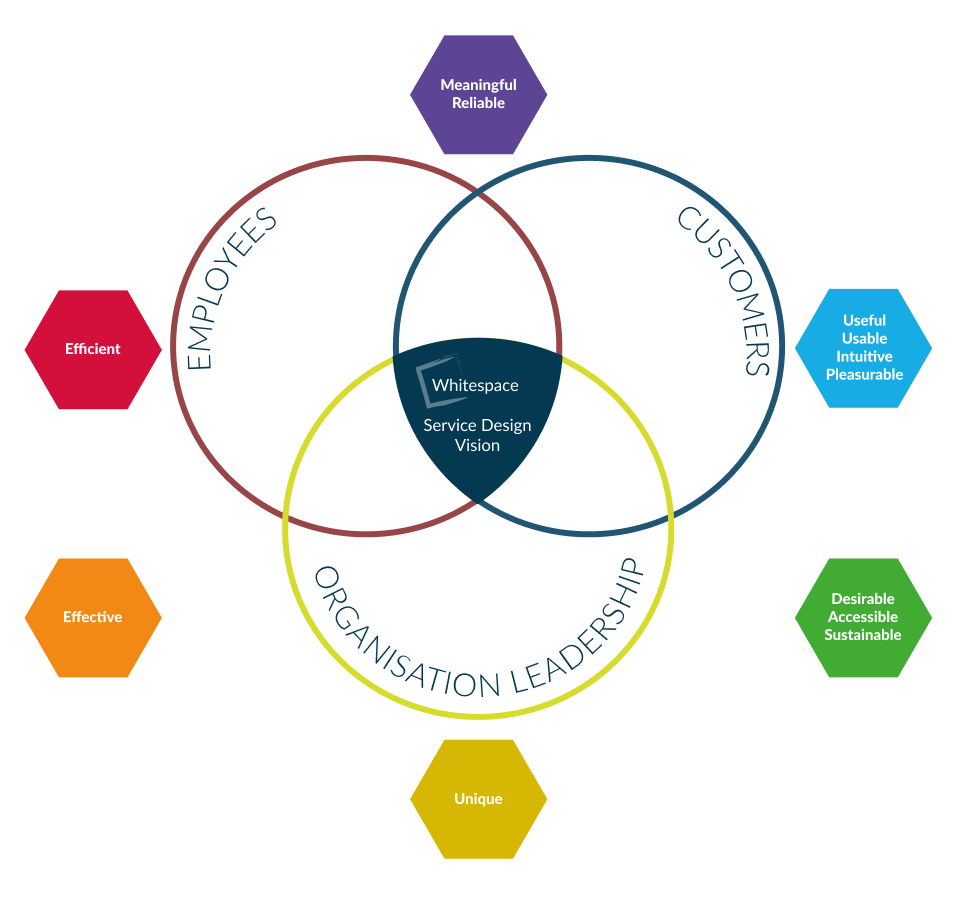
But we don’t stop there — we continue explaining how some intangible outcomes overlap between our protagonists, namely:
- desirable, accessible and sustainable for the combination of customers & organization,
- effective for the combination of organization & employees,
- meaningful and reliable for the combination of employees & customers
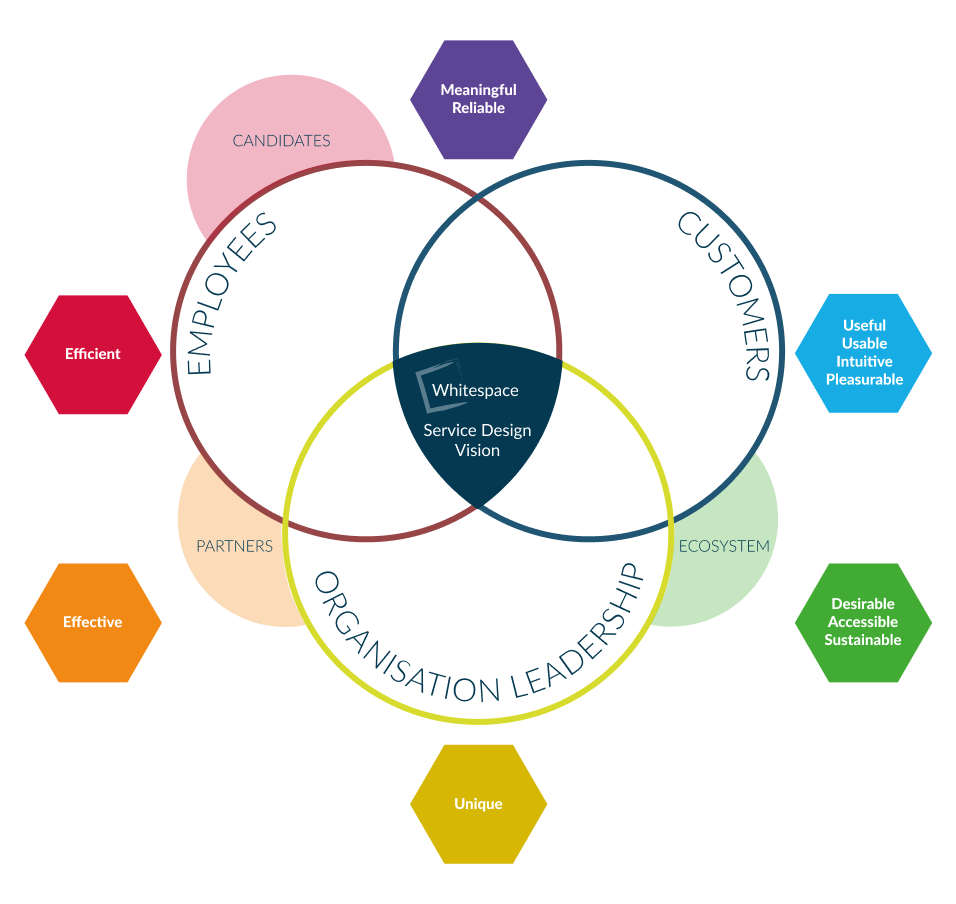
As with any good story, we must also consider the secondary characters and foils who bring the primary characters into greater perspective. These are the candidates, the partners, and the wider ecosystem (both social and environmental). Notice how the intangible outcomes now overlap meaningfully between both the main and secondary stakeholders.
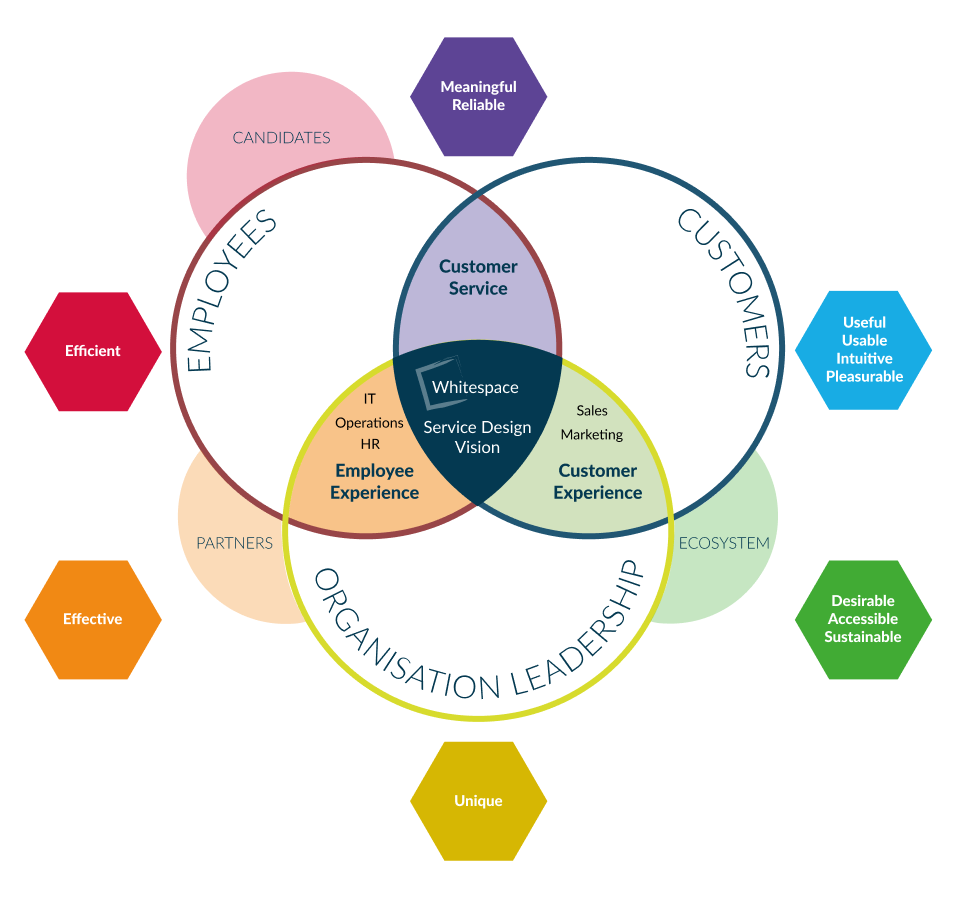
Let’s round off the picture by highlighting some relevant departments in the organization. This gives us an opportunity to demonstrate our fluency in the industry or business, as well as weaving our audience into the narrative.
This step also identifies three areas to address through SD: customer service, customer experience, and employee experience.
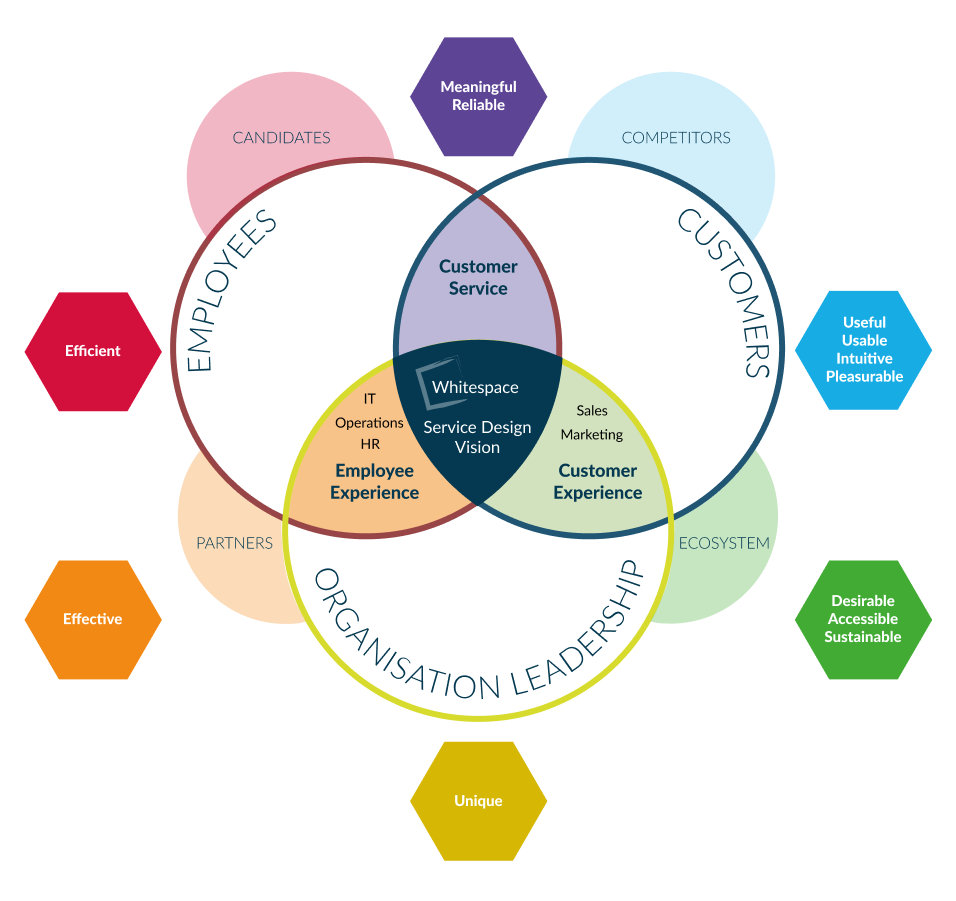
There is one more participant left. An important one. The nemesis of our story: the competitors!
While an organization should focus on itself rather than other players, but benchmarking, SWOT and other business tools do take competitors into account too — and SD shouldn’t miss out either.
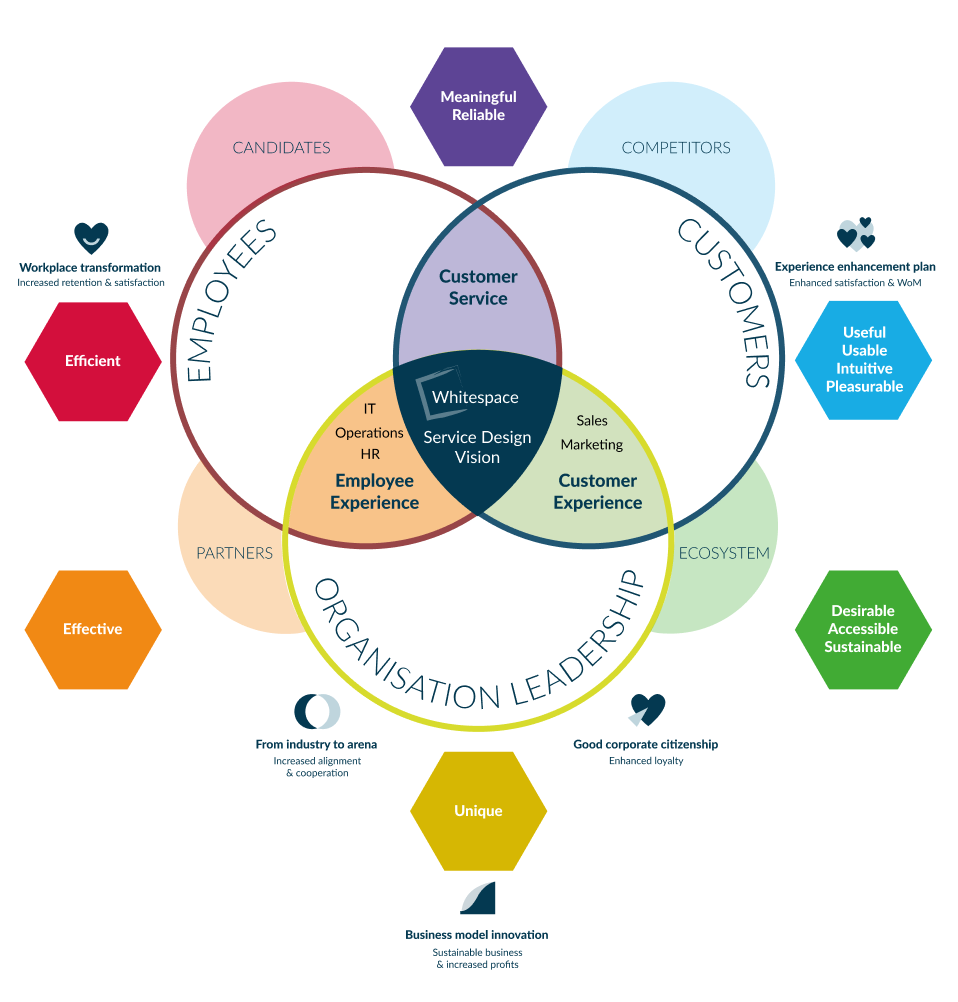
It is against and despite this nemesis that Service Design can help the organization achieve its business outcomes (to attain the delivered value):
- Experience enhancement (for enhanced satisfaction & WoM)
- Workplace transformation (for increased retention & satisfaction)
- Moving from industry to arena (for increased alignment & cooperation)
- Good corporate citizenship (for enhanced loyalty)
III. Navigating the narrative — the four approaches
Now that all the characters and their interconnections have been clearly mapped out, a conversation can be had within the company to identify low-hanging fruit and strategic bets for a Service Design approach, and define priorities.
As this discussion develops, four approaches of Service Design will unfold. Represented by the dotted arrows, each of these approaches is a series of smaller projects, with a start- and end-point, and a pre-defined direction:
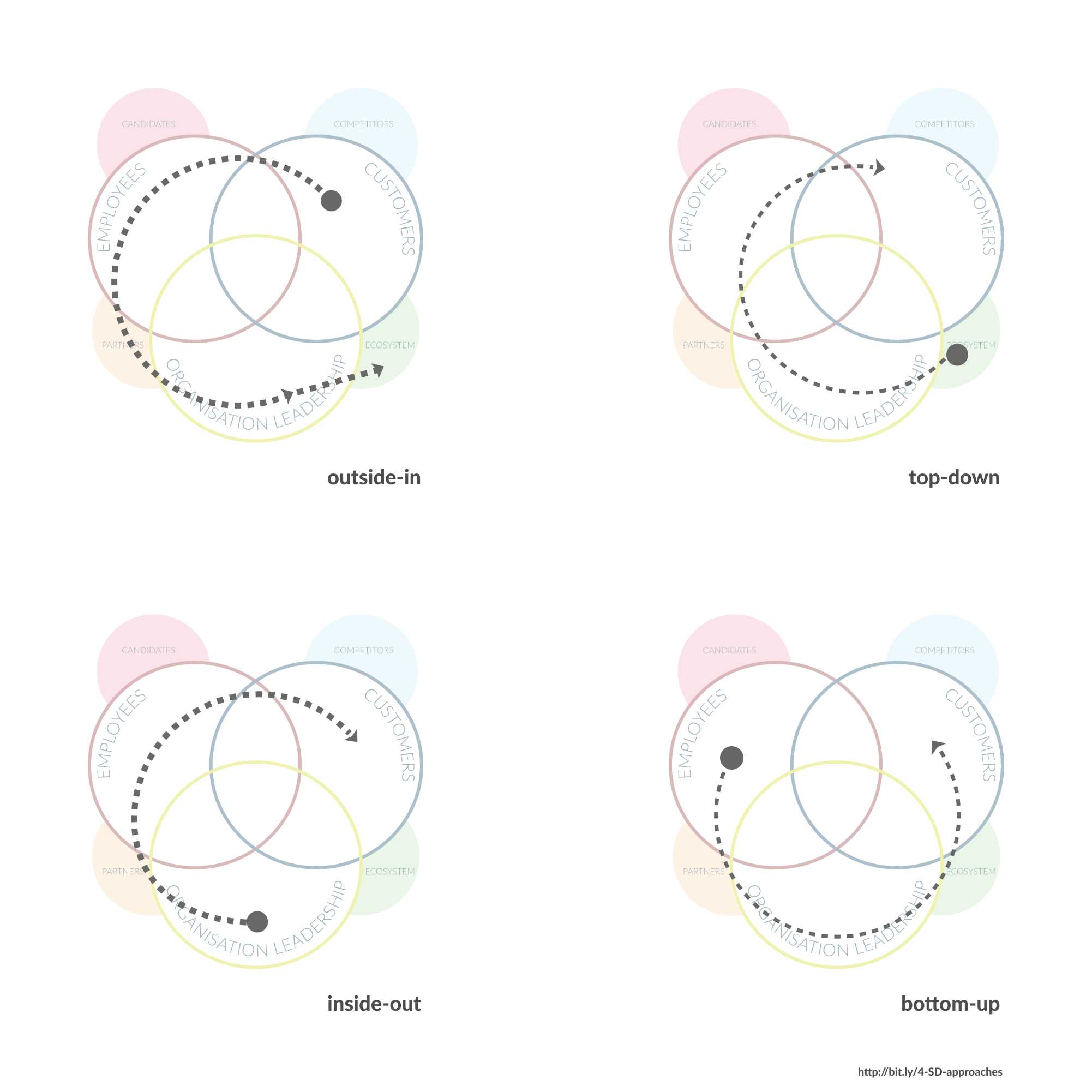
- The outside-in approach — classic and customer-focused. The projects start on the customer side, cross over to the employees, touch on the partners, include the organization, and either end there, or go one step further, into the ecosystem.
- The top-down approach, where the change is driven by the ecosystem, which the organization realizes it needs to address. Driven by this competitive pressure, the change starts within the organization, then partners are involved, along with the employees, and the project culminates with customer-focused elements.
- The inside-out approach is the only one originating within the organization itself. In today’s reality where industries are being replaced by arenas (HBR), this cannot be achieved without partners. So our project-series arrow passes through this area more prominently. Like in the previous approach, customer-focused activities are the very last activities to be addressed, otherwise they are not sustainable.
- The bottom-up approach is an internal grassroots variant, starting with the employees. This may start with tiny, customer-facing pilot projects. But lasting change can only be sustained in this case if the organization enables internal innovation, embraces the employee push, and finally extends it to customers.
We do not believe that further approaches should be the remit of Service Design. This is a systemic discipline that may start with a pilot or one-off project, but a strategic goal should be in mind from the beginning. Failing to traverse participants in the above order, or reversing the direction is, in our view, not a recipe for sustainable results.
IV. Defining a remit and responsibilities
After breaking down Service Design into its elements, identifying its gaps, and then constructing a narrative, we arrive at the final piece of our proposal: defining a remit and responsibilities.
All that we discussed above points to a clear remit for Service Design: orchestration and co-creation. Of course, this thought is not new — nor should it be. We did not set out to re-invent Service Design, just to define its ‘missing middle’ narrative. Orchestration of and co-creation with all internal and external stakeholders is a clear primary remit that the discipline can stand behind. And this remit is not currently claimed by any other team.
Introducing feedback loops
This is our proposal. Think of it as a first iteration. And like with any design process, this should evolve through testing and feedback. We are consulting the above proposal with service designers, technologists, and business leaders to stress-test it. And we are equally curious about your thoughts. How would this help you lead discussions with Business and IT? What is missing? How have you been filling the missing middle of Service Design?
Contact us if you want to dive deeper into this discussion.
This article first appeared here.

